Plum variety Yellow Hopty
The yellow-fruited plum looks very unusual and cheerful in regions where the climate is not quite suitable for gardening, and even more so for such heat-loving crops. But, nevertheless, there have long been varieties that successfully bear fruit in harsh climates. Among them is the Yellow Hopty, which has become famous since 1930. This species appeared thanks to the interest of the breeder N.N. Tikhonov to the crops growing in the garden of the Ussuri amateur gardener named Hopty (the culture was named after him). The scientist identified this particular variety, studied it, and further contributed to its spread in the Urals, the Far East and Siberia. It is in these regions that plum has occupied a leading position for a long time. In 1974, the variety was zoned and allowed for cultivation in the Ural (Kurgan, Orenburg, Chelyabinsk regions and the Republic of Bashkortostan) and West Siberian (Altai Republic and Altai Territory, Tomsk, Tyumen, Omsk, Novosibirsk, Kemerovo regions) regions. Yellow Hopty is used in breeding to breed new species. With her participation, the Altai Dawn and several more promising forms were created in Altai, and Divnaya in Krasnoyarsk.
Description
The tree reaches a height of 2.5 meters, has a short bole, a sparse and spreading crown of a flat-round shape. The bark of skeletal branches is grayish, smooth. Shoots are thick, growing straight or with a slight bend, bark with a slight gloss, smooth, light brown shade with numerous light lenticels. Fruit buds are of normal size, round, vegetative small and conical in shape. Plum fruiting mainly occurs on bouquet branches. Leaves are medium in size, 11 cm long, 6 cm wide, green. The shape is ovoid, the wide part of the leaf plate is shifted to the apex, the base is wedge-shaped, the tip is sharp, slightly curled, the edge is even, crenate. The surface of the leaf is slightly wrinkled, slightly glossy, not pubescent. On the young part of the shoot, the leaf is folded like a boat, on the old part it is unfolded, open. The inflorescence of the variety consists of 2 - 3 white flowers. Having blossomed, the flowers of the Yellow Hopta acquire a cupped shape. The size is normal, the petals are contiguous, obovate, with a wavy edge, length 9 mm, width 6 mm. The stigma of the pistil is at the same level as the anthers.
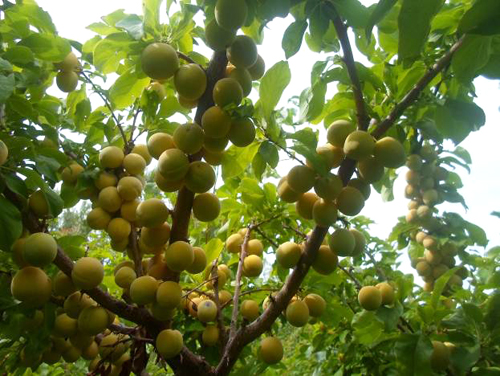
Fruits are round, slightly flattened. Weight 12 - 14 grams. The funnel is small, the abdominal suture is pronounced. The skin is smooth, thin, the color of the plum is light yellow, a white waxy coating is present in an insignificant degree. The pulp is yellow-green, friable, juicy. The taste of the variety is good - sweet and sour, the aroma is not pronounced. The skin is bitter, the bitterness remains even after processing. The stone is rather large, rounded, easily separates from the pulp. The content of substances in 100 grams of pulp: dry matter 14.5% - 21.8%, sugars 10.2 - 13.6%, titratable acids 1.2 - 1.7%, tannins 0.45 - 0.74% , ascorbic acid 2 - 12 mg, P-active substances 150 mg.
Characteristics
- Entry into the fruiting period at Yellow Hopta occurs at the usual time - 4 years after planting a one-year-old seedling;
- the crop ripens in mid-late terms - in late August - early September;
- regular fruiting, no recessions were observed;
- one tree brings up to 10 - 13 kg of fruit, in large orchards this figure is 40 - 60 kg / ha;
- the ripe crop must be removed on time, otherwise the fruits may crumble;
- winter hardiness of the variety is excellent, especially for wood. In fruit buds, winter hardiness is slightly lower, at an average level;
- excellent adaptability of the plum allows its wide use in areas of risky farming, which are characterized by constant temperature drops, rainy and short summers;
- Yellow Hopty is self-fertile, therefore it requires a number of pollinators blooming at the same time as it;
- the immunity of the plum is average - it is moderately resistant to clotterosporia and hawthorn damage. Severely damaged by Maslov's seed eater;
- the tree is subject to damping, therefore, in especially snowy winters, the trunk must be protected;
- transportation of fruits is poorly tolerated, their appearance can deteriorate greatly;
- the way of eating fruit is in its natural form. If you make jam or preserves from them, it is better to first remove the skin by pouring boiling water over them. For the same reason, the fruits of the Yellow Hopta are not suitable for compote.
Planting and leaving
Given the climatic conditions of the growing regions, it is best to plant plums in the spring. During the growing season, the variety will have time to grow the main and absorbent roots, and the wood will have time to lignify. In order for the survival rate to be successful, select seedlings no older than 3 years. The site must be well lit, protected from strong winds. The groundwater level should not come closer than 1, 5 - 2 meters to the surface. A hollow cylinder made of moisture-resistant material, which is fixed around the trunk, will save from damping out in winter. It will prevent the snow from touching the bark. Preventive spraying against diseases and pests is mandatory. Reproduction takes place through grafting. Otherwise, the care is no different from the standard plum farming technique.
Yellow Hopty, with high adaptability, is an unpretentious and successful variety for problem regions. With fairly simple maintenance, the tree produces a good annual harvest. A small minus is the bitter skin and damping off of the bark, which can be eliminated through "dry wintering".

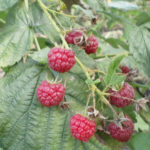
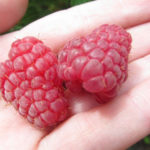

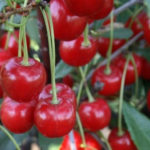
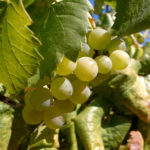



For many years, this plum grew in my father's garden, they brought it from a nursery in Barnaul. Her yield was simply fantastic. The fruit is so sweet in other years that guests often mistook it for an apricot. There was also a pink barrel on the fruit. And the wax coating is not quite mature. They made compotes - delicious. The tree itself is very beautiful, with a large round-flat crown and spreading branches. In the spring - indescribable beauty ... ... But once a shield attacked her and that's it - the tree died, how many plum saplings were planted later - everyone died. We can't get rid of the scabbard.